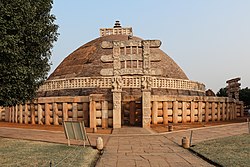
Back Stoepa Afrikaans إسطبة Arabic Estupa AST Əstup Azerbaijani Ступа (архітэктура) Byelorussian Ступа Bulgarian स्तूप Bihari স্তূপ Bengali/Bangla Субарга BXR Stupa Catalan
This article contains too many pictures for its overall length. (March 2025) |
| Translations of Stupa | |
|---|---|
| English | Stupa |
| Sanskrit | स्तूप |
| Pali | 𑀣𑀼𑀩𑁂 ("thube"), thūpa |
| Bengali | স্তূপ (stup) |
| Burmese | စေတီ (MLCTS: zèdì) |
| Chinese | 窣堵坡 (Pinyin: sūdǔpō) |
| Japanese | 卒塔婆 (Rōmaji: sotoba) |
| Khmer | ចេតិយ, ស្តូប (UNGEGN: chétĕy, stob) |
| Korean | 솔도파 (RR: soldopha) |
| Mon | စေတဳ ([ce.tɔe]) |
| Mongolian | суварга (suvarga) |
| Shan | ၵွင်းမူး ([kɔŋ˥.muː˥]) |
| Sinhala | දාගැබ් (dagab) |
| Tibetan | མཆོད་རྟེན་ (mchod rten (chorten)) |
| Tamil | தாது கோபுரம் |
| Thai | สถูป, เจดีย์ (RTGS: sa thup, chedi) |
| Vietnamese | Phù đồ, bảo tháp |
| Glossary of Buddhism | |
| Part of a series on |
| Buddhism |
|---|
 |
In Buddhism, a stupa (Sanskrit: स्तूप, lit. 'heap', IAST: stūpa) is a domed hemispherical structure containing several types of sacred relics, including images, statues, metals, and śarīra—the remains of Buddhist monks or nuns. It is used as a place of pilgrimage and meditation.[1]
Walking around a stupa in a clockwise direction, known as pradakhshina, has been an important ritual and devotional practice in Buddhism since the earliest times, and stupas always have a pradakhshina path around them. The original South Asian form is a large solid dome above a tholobate, or drum, with vertical sides, which usually sits on a square base. There is no access to the inside of the structure. In large stupas, there may be walkways for circumambulation on top of the base as well as on the ground below it. Large stupas have, or had, vedikā railings outside the path around the base, often highly decorated with sculpture, especially at the torana gateways, of which there are usually four. At the top of the dome is a thin vertical element, with one or more horizontal discs spreading from it. These were chatras, symbolic umbrellas, and have not survived, if not restored. The Great Stupa at Sanchi in Madhya Pradesh, is the most famous and best-preserved early stupa in India.
Apart from very large stupas, there are many smaller stupas in a range of sizes, which typically have much taller drums, relative to the height of the dome. Small votive stupas built by or paid for by pilgrims might be less than a metre high, and laid out in rows by the hundred, as at Ratnagiri, Odisha, India.
The principal design of the stupa may have been influenced by the shikharas seen on Hindu temples. As Buddhism spread across Asia via the Silk Road, stupas were stylistically altered into other cultural and structural forms used for the same purposes, like the pagodas of East Asian Buddhism or the chortens of Tibetan Buddhism.[2][3] In Southeast Asia, various different elongated shapes of domes evolved, leading to high, thin spires. A related architectural term is a chaitya, which is a prayer hall or temple containing a stupa.
- ^ encyclopedia.com. Credited to James Stevens Curl, A Dictionary of Architecture and Landscape Architecture, 2000, originally published by Oxford University Press 2000.
- ^ Harle, James Coffin (1994). The art and architecture of the Indian subcontinent (2nd ed.). New Haven London: Yale University Press. p. 201. ISBN 978-0-300-06217-5.
- ^ Michell, George (1990). The Penguin guide to the monument of India. London: Penguin book. pp. 228–229. ISBN 978-0-14-008144-2.
© MMXXIII Rich X Search. We shall prevail. All rights reserved. Rich X Search



